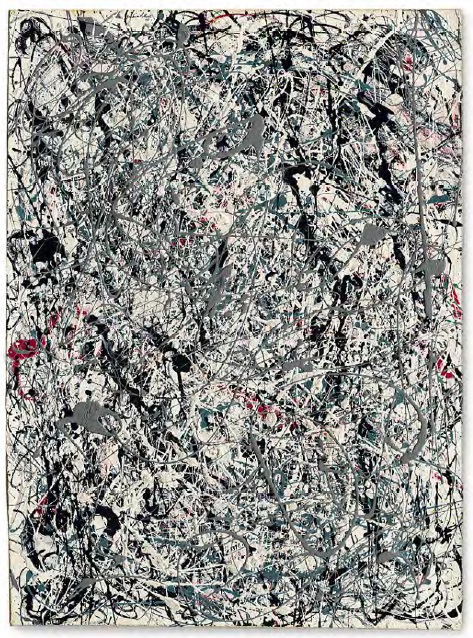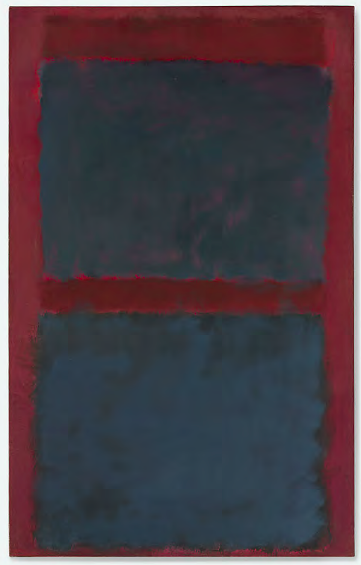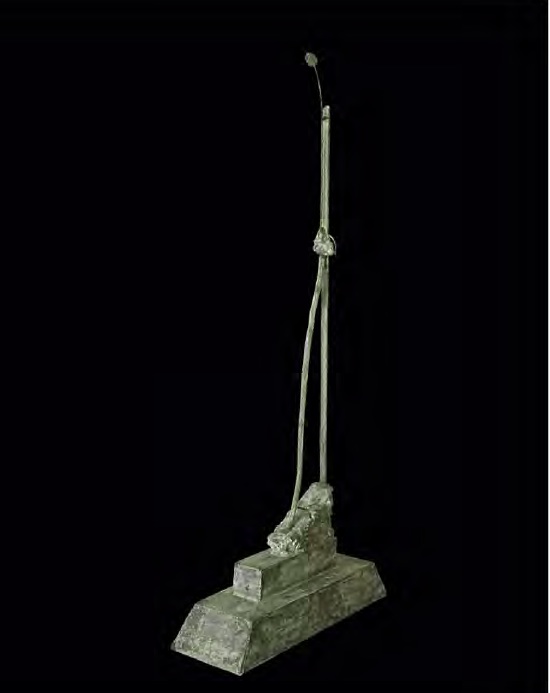Silvery $58.3 million Jackson Pollock painting leads Christie’s $495 million Record Breaking Contemporary Art Sale

Lot 18. Jackson Pollock (1912-1956)
Number 19, 1948
signed and dated ‘Jackson Pollock 48’ (upper left)
oil and enamel on paper mounted on canvas
30 7/8 x 22 5/8 in. (78.4 x 57.4 cm.)
Painted in 1948.
Estimate: $25-35 million. This lot sold for a hammer price of $52 million ($58,363,750 with the buyer’s premium)
UPDATE: Last night’s sale of Post War and Contemporary yielded a whopping $495,021,500, $200 million more than the Sotheby’s sale the night before – and broke the record for the highest total for any auction – the $491.4 million that was set at Christie’s Impressionist & Modern sale in November 2006. According to a Christie’s press release issued at 12:38 AM, 16 new artist records were set, 3 works sold above $40 million, 9 above $10 million, and 59 above $1 million.
The first major mega-bucks work, lot 10, Jean-Michel Baquiat’s 1982 Dustheads, estimated at $25-35 million, trounced the artist’s previous auction of $26,402,500 (set just last November), and sold for a hammer price of $43.5 million ($48,843,750 with the buyer’s premium). The Jackson Pollock, sold by Washington, DC-based collector Mitchell Rales, blew past its $25-35 million estimate and sold for a hammer price of $52 million ($58,363,750 with buyer’s premium).
Judd Tully’s Artinfo.com coverage of the sale includes this about the bidding war for the Pollock:
A dozen artist records were set, led by the ravishing cover lot, Jackson Pollock’s small but mighty “Number 19, 1948,” a stunning drip painting in oil and enamel on paper mounted on canvas, which sold to an anonymous telephone bidder for a whopping $58,363,750 (est. $25-35 million). The epic bidding battle for the Pollock began at $18 million and quickly escalated at million-dollar increments to a point where three bidders were still competing at the $40 million plus mark, including dealers Jose Mugrabi and Dominique Levy.
Described in the catalogue as the property of an American foundation, the shimmering painting, which last sold at auction at Christie’s New York in May 1993 for $2,422,500, subsequently entered the collection of Potomac, Maryland billionaire Mitchell Rales and his Glenstone Foundation. The price obliterated the mark set by “Number 4,” a 1951 canvas that made $40,402,500 at Sotheby’s New York last November.
Later in the sale, Roy Lichtenstein’s Picasso-inspired Woman with a Flowered Hat, which was begin sold by the New York-based investor Ronald Perelman, sailed through its unpublished $30-40 million estimate to sell for $50 million ($56,123,750 with the buyer’s premium) to London-based Laurence Graff, who purchased the painting as a present to himself in advance of his 75th birthday. According to Tully’s article:
“I got a masterpiece and I’m very lucky, because it’s one of four ladies Lichtenstein did and this is the best example,” said a still-elated Graff, buttonholed outside Christie’s Rockefeller Center headquarters. “There are fewer and fewer masterpieces coming to market and I love this painting.” Graff also cracked that it is just weeks away from his birthday, “so it’s going to be my birthday present.”
The painting mashed the previous high set a year ago at Sotheby’s New York when Lichtenstein’s “Sleeping Girl” (1964) sold for $44,882,500.
ORIGINAL POST: Christie’s May 15, 2013 evening sale of Post War and Contemporary Art features a pu-pu platter of styles among the top lots including Abstract Expressionism, Pop, Neo-Expressionism and more. Among the sale’s 72 lots (estimated to yield some $300 million), are works by art world luminaries (and box office gold) including Francis Bacon, Jean-Michel Basquiat, Roy Lichtenstein, Jackson Pollock and Mark Rothko.
One of the most expensive is a dazzling and wondrous silvery Jackson Pollock from 1948 (above), smack in the middle of the period when he created a series of paintings that revolutionized Post War art and helped establish New York and Abstract Expressionists as the center of the contemporary art world. According to the catalogue notes:
Number 19, 1948, was singled out as one of the finest of Pollock’s achievements to date by the great pioneering champion of Abstract Expressionism, Clement Greenberg, when it was first shown at the artist’s second solo exhibition at the Betty Parsons Gallery in January 1949. “The general quality that emerged from such pictures,” Greenberg wrote, “especially (Number) Nineteen, seemed more than enough to justify the claim that Pollock is one of the major painters of our time” (C. Greenberg, The Nation, 19 February, 1949, reproduced in J. O’Brian (ed.), Clement Greenberg, The Collected Essays and Criticism, Vol. 2 Arrogant Purpose, 1945-1949, Chicago, 1986, pp. 285-6).
Given the auction houses’ penchant for aggressively estimating top lots, this painting’s $25-35 million estimate actually seems tame.

Lot 10. Jean-Michel Basquiat (1960-1988)
Dustheads
signed, titled and dated ‘DUSTHEADS Jean-Michel Basquiat 82’ (on the reverse)
acrylic, oilstick, spray enamel and metallic paint on canvas
72 x 84 in. (182.8 x 213.3 cm.)
Painted in 1982.
Estimate: $25-35 million. This lot sold for a hammer price of $43.5 million ($48,843,750 with the buyer’s premium).
The Basquiat, which has a third party guarantee (meaning it will be sold), was created when the artist was becoming an international star. The catalogue entry includes this about the title some context from the artist:
The title itself refers to the street slang for habitual users of angel dust, the drug also known as PCP. Abused for its psychotropic qualities, the iconography of this particular painting–the vivid colors, rapid sense of frenetic movement and even the dilated eyes on both figures–lead to the drawing of clear parallels between the hallucinogenic properties of the angel dust and Basquiat’s own unique visual aesthetic. Looking back on 1982, Basquiat himself recognized the tensions that he felt between the draw of his humble beginnings as a graffiti artist and his meteoric rise to become the wunderkind of the New York art world. “I had some money,” he recalled of that important year, “I made the best paintings ever. I was completely reclusive, worked a lot, took a lot of drugs. I was awful to people (J. Basquiat, in R. Marshall (ed.), Jean-Michel Basquiat, exh. cat., Whitney Museum of American Art, New York, 1992, p. 241).

Lot 34. Roy Lichtenstein (1923-1997)
Woman with Flowered Hat
signed and dated ‘rf Lichtenstein ’63’ (on the reverse)
Magna on canvas
50 1/8 x 40¼ in. (127.3 x 102.2 cm.)
Painted in 1963.
Estimate on Request (approximately $30-40 million). This lot sold for a hammer price of $50 million ($56,123,750 with the buyer’s premium), to London-based Laurence Graff.
The Lichetenstein, which also has a third party guarantee, was created only two years after the artist settled on his signature Pop style based on commercial art and comics. According to the catalogue entry:
Between 1962-63, Lichtenstein produced four paintings based on Picasso’s portraits of women: Femme au chapeau(1962, Private Collection), Femme d’Alger, (1963, The Eli and Edyth L. Broad Collection), Femme dans un fauteuil(1963, Nationalgalerie, Berlin), and the present work. Woman with Flowered Hat was the fourth in the series, and it is based on a reproduction sent to Lichtenstein by Morton Neumann, a Chicago businessman and art collector who owned the original Picasso painting and had lately begun acquiring Pop Art as well. The subject of Woman with Flowered Hatis Dora Maar, Picasso’s muse and lover from 1936 to the mid-1940s.
…
Out of all the genres Lichtenstein turned his hand to it was Picasso who perhaps made the most natural target as his work was so well-known that it essentially was already Pop: “a Picasso has become a kind of popular object,” he stated, “one has the feeling there should be a reproduction of Picasso in every home” (R. Lichtenstein, quoted in J. Hendrickson, Roy Lichtenstein, Cologne, 2000, p. 59).

Lot 46. Francis Bacon (1909-1992)
Study for Portrait
signed, titled and dated ‘Study for Portrait 1981 Francis Bacon’ (on the reverse)
oil on canvas
78 1/8 x 58 1/8 in. (198.4 x 147.6 cm.)
Painted in 1981.
Estimate: $18-25 million. This lot was withdrawn from sale.
According to the catalogue entry, this painting was acquired by the present owner from Marlborough in 1983 and presuming it hasn’t been on the market privately (and shopped out), it is fresh material and should do well. The catalogue includes this section:
The principal image in Study for Portrait is of a seated, nude George Dyer. Variations of Dyer’s cross-legged pose had first been employed by Bacon in Portrait of George Dyer Staring at Blind-cord and Portrait of George Dyer Talking, in 1966, utilising John Deakin’s photographs of Dyer, taken in Bacon’s Reece Mews studio, circa 1965. Bacon would continue to paint variations on the theme of a nude male figure, seated and with crossed legs, up until 1990, latterly transposing the ‘sitter’s’ identity, at least facially, to John Edwards.
George Dyer had died in Paris on October 24, 1971, two days before the opening of Bacon’s major retrospective at the Grand Palais.
Here are the additional top estimates lot followed by two works by Cy Twombly:

Lot 21. Clyfford Still (1904-1980)
PH-1
signed and dated ‘Clyfford 53’ (lower left); signed again, dated again and inscribed ‘Clyfford 1953 S.F.’ (on the reverse)
oil on canvas
79 x 68½ in. (200.7 x 174 cm.)
Painted in 1953.
Estimate: $15-20 million. This lot was unsold.

Lot 55. Mark Rothko (1903-1970)
Untitled (Black on Maroon)
signed and dated ‘MARK ROTHKO 1958’ (on the reverse)
oil on canvas
72 x 45 in. (182.8 x 114.3 cm.)
Painted in 1958.
Estimate: $15-20 million. This lot sold for a hammer price of $24 million ($27,003,750 with the buyer’s premium).
Both of the Twomblys (below) have third party guarantees.

Lot 33. Cy Twombly (1928-2011)
Untitled (Rome)
signed with initials and numbered ‘C.T. 5/6’ (on the base)
bronze
76¼ x 12 1/8 x 31 in. (193.6 x 30.7 x 78.7 cm.)
Executed in 1987. This work is number five from an edition of six.
Estimate: $6-8 million. This lot sold for a hammer price of $6.8 million ($7,739,750 with the buyer’s premium).
![Lot 44. Cy Twombly (1928-2011) Untitled [Gaeta] inscribed and dated 'Gaeta Aug'(upper left); signed with initials and dated again 'CT 00' (lower left); signed, titled and dated again 'Cy Twombly Gaeta 00' (on the reverse) oil based house paint, acrylic, wax crayon, lead pencil and paper collage on wooden panel 49½ x 72¾ in. (125.7 x 184.7 cm.) Executed in 2000. Estimate: $5-7 million.](https://nordonart.files.wordpress.com/2013/05/5-7-lot-44.jpg?w=600&h=415)
Lot 44. Cy Twombly (1928-2011)
Untitled [Gaeta]
inscribed and dated ‘Gaeta Aug'(upper left); signed with initials and dated again ‘CT 00’ (lower left); signed, titled and dated again ‘Cy Twombly Gaeta 00’ (on the reverse)
oil based house paint, acrylic, wax crayon, lead pencil and paper collage on wooden panel
49½ x 72¾ in. (125.7 x 184.7 cm.)
Executed in 2000.
Estimate: $5-7 million. This lot sold for a hammer price of $5.6 million ( $6,395,750 with the buyer’s premium).